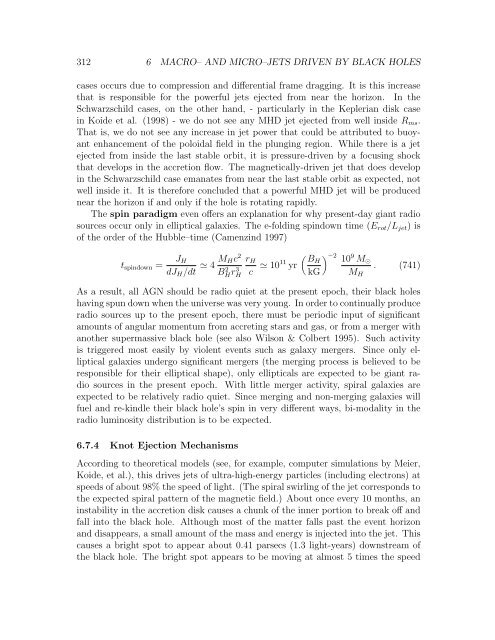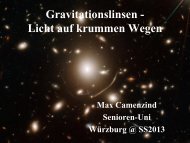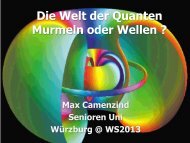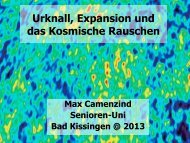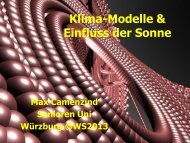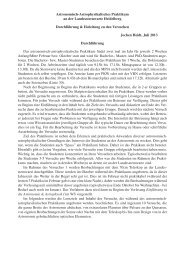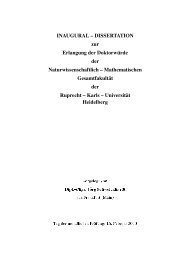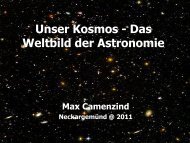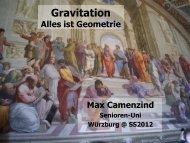Contents List of Figures
Contents List of Figures
Contents List of Figures
You also want an ePaper? Increase the reach of your titles
YUMPU automatically turns print PDFs into web optimized ePapers that Google loves.
312 6 MACRO– AND MICRO–JETS DRIVEN BY BLACK HOLES<br />
cases occurs due to compression and differential frame dragging. It is this increase<br />
that is responsible for the powerful jets ejected from near the horizon. In the<br />
Schwarzschild cases, on the other hand, - particularly in the Keplerian disk case<br />
in Koide et al. (1998) - we do not see any MHD jet ejected from well inside Rms.<br />
That is, we do not see any increase in jet power that could be attributed to buoyant<br />
enhancement <strong>of</strong> the poloidal field in the plunging region. While there is a jet<br />
ejected from inside the last stable orbit, it is pressure-driven by a focusing shock<br />
that develops in the accretion flow. The magnetically-driven jet that does develop<br />
in the Schwarzschild case emanates from near the last stable orbit as expected, not<br />
well inside it. It is therefore concluded that a powerful MHD jet will be produced<br />
near the horizon if and only if the hole is rotating rapidly.<br />
The spin paradigm even <strong>of</strong>fers an explanation for why present-day giant radio<br />
sources occur only in elliptical galaxies. The e-folding spindown time (Erot/Ljet) is<br />
<strong>of</strong> the order <strong>of</strong> the Hubble–time (Camenzind 1997)<br />
tspindown = JH<br />
dJH/dt<br />
4 MHc 2<br />
B 2 Hr 3 H<br />
rH<br />
c 1011 yr<br />
−2 9<br />
BH 10 M⊙<br />
. (741)<br />
kG MH<br />
As a result, all AGN should be radio quiet at the present epoch, their black holes<br />
having spun down when the universe was very young. In order to continually produce<br />
radio sources up to the present epoch, there must be periodic input <strong>of</strong> significant<br />
amounts <strong>of</strong> angular momentum from accreting stars and gas, or from a merger with<br />
another supermassive black hole (see also Wilson & Colbert 1995). Such activity<br />
is triggered most easily by violent events such as galaxy mergers. Since only elliptical<br />
galaxies undergo significant mergers (the merging process is believed to be<br />
responsible for their elliptical shape), only ellipticals are expected to be giant radio<br />
sources in the present epoch. With little merger activity, spiral galaxies are<br />
expected to be relatively radio quiet. Since merging and non-merging galaxies will<br />
fuel and re-kindle their black hole’s spin in very different ways, bi-modality in the<br />
radio luminosity distribution is to be expected.<br />
6.7.4 Knot Ejection Mechanisms<br />
According to theoretical models (see, for example, computer simulations by Meier,<br />
Koide, et al.), this drives jets <strong>of</strong> ultra-high-energy particles (including electrons) at<br />
speeds <strong>of</strong> about 98% the speed <strong>of</strong> light. (The spiral swirling <strong>of</strong> the jet corresponds to<br />
the expected spiral pattern <strong>of</strong> the magnetic field.) About once every 10 months, an<br />
instability in the accretion disk causes a chunk <strong>of</strong> the inner portion to break <strong>of</strong>f and<br />
fall into the black hole. Although most <strong>of</strong> the matter falls past the event horizon<br />
and disappears, a small amount <strong>of</strong> the mass and energy is injected into the jet. This<br />
causes a bright spot to appear about 0.41 parsecs (1.3 light-years) downstream <strong>of</strong><br />
the black hole. The bright spot appears to be moving at almost 5 times the speed


